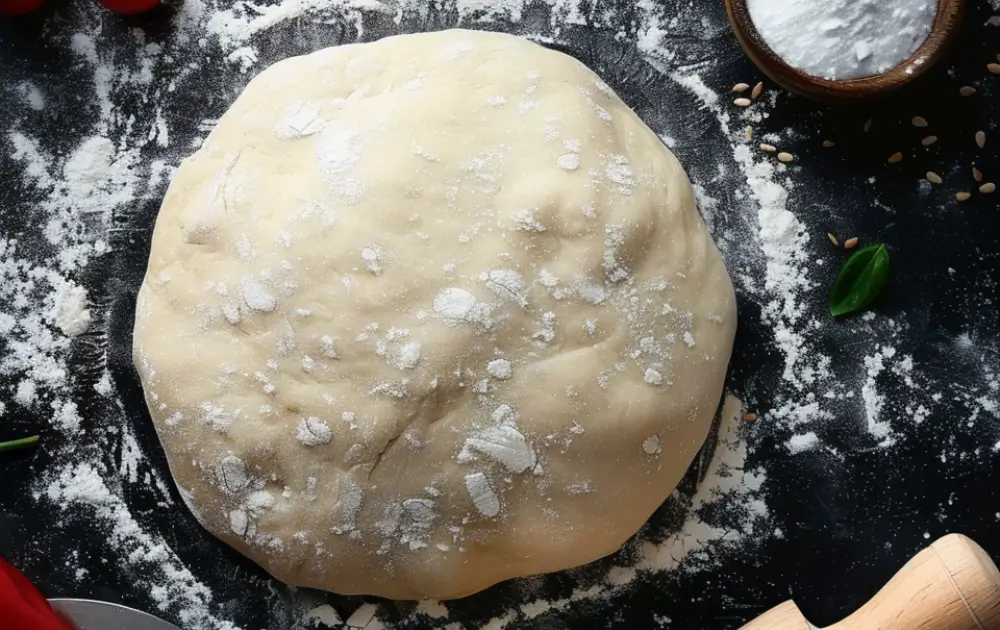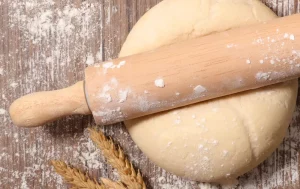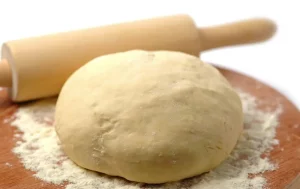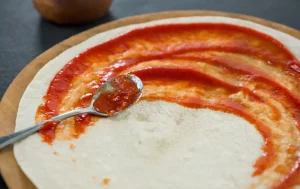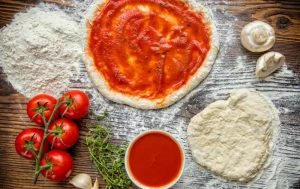The journey to perfecting homemade pizza dough is embraced by many as a testament to the art of baking, where simplicity meets sophistication. Made from a blend of humble ingredients, the dough serves as the canvas for an array of flavors and toppings, making each pizza a unique culinary masterpiece.
Ingredients and Their Significance
At the heart of pizza dough, flour, water, yeast, and salt are combined, each playing a pivotal role. A high-protein flour is often selected for its ability to produce a dough with the desired chewiness and structure. Warm water is mixed with the flour, activating the gluten and contributing to the dough’s elasticity. Yeast, revered for its fermenting capabilities, is introduced to the mixture, where it embarks on a process of fermentation, essential for the dough to rise and develop its characteristic flavor. The addition of salt not only enhances taste but also regulates the activity of the yeast and strengthens the gluten network.
FAQs about Homemade Pizza Dough
Q: Can I use instant yeast instead of active dry yeast for my pizza dough?
A: Yes, you can use instant yeast in place of active dry yeast. The main difference is that instant yeast doesn’t need to be dissolved in water first and can be mixed directly with the dry ingredients. You might notice a slight decrease in rising time due to the more potent nature of instant yeast.
Q: How long can pizza dough be stored in the refrigerator?
A: Pizza dough can be stored in the refrigerator for up to 3 days. Make sure it’s tightly covered or stored in an airtight container to prevent it from drying out. This cold fermentation process can actually improve the flavor and texture of your dough.
Q: Is it necessary to use a pizza stone or baking steel?
A: While not strictly necessary, using a pizza stone or baking steel can greatly enhance the quality of your homemade pizza. These baking surfaces distribute heat more evenly and store more heat than a regular baking sheet, leading to a better rise and a crispier crust.
Q: Can I make pizza dough without a stand mixer?
A: Absolutely! You can make pizza dough by hand by mixing the ingredients in a bowl and then kneading the dough on a floured surface. It’s a bit more labor-intensive but can be a fun and rewarding process.
Q: Why did my pizza dough not rise?
A: If your pizza dough didn’t rise, it could be due to a few reasons: the yeast was old and inactive, the water temperature was too hot or too cold, or the dough was not allowed enough time to ferment. Always check the expiration date on your yeast and try to keep your water around 110°F (43°C) for optimal yeast activation.
Print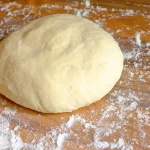
Homemade Pizza Dough
- Author: recipstep
- Total Time: 0 minute
Description
Homemade pizza dough forms the base for countless delicious pizza creations. It’s a simple mixture of flour, yeast, water, oil, and salt, kneaded into a smooth, elastic dough. Ideal for making customized pizzas with your favorite toppings.
Ingredients
2 1/2 cups all-purpose flour
1 teaspoon salt
1 teaspoon sugar
1 tablespoon yeast
1 1/3 cups warm water (about 110°F/45°C)
2 tablespoons olive oil
Instructions
Notes
- For best results, let the dough rest for at least 24 hours in the refrigerator for better flavor and texture.
- You can add herbs or garlic powder to the dough for extra flavor.
- Prep Time: 20 minutes (plus 1 hour for rising)
- Cook Time: Cook Time: 15 minutes
- Category: Base
- Method: Baking
- Cuisine: Italian
Nutrition
- Calories: 1060
- Sugar: 2g
- Sodium: 2340mg
- Fat: 14g
- Saturated Fat: 2g
- Carbohydrates: 200g
- Fiber: 8g
- Protein: 28g
- Cholesterol: 0mg
The Mixing and Resting Phases
In the initial stages, the yeast is dissolved in warm water, a step that confirms its viability. This mixture is then incorporated into the dry ingredients, where a thorough mixing leads to the formation of a sticky dough. Allowed to rest, the dough undergoes autolysis, during which hydration of the flour and natural development of gluten take place, setting the stage for a successful kneading process.
Kneading and the Development of Gluten
Through kneading, either by hand or with a dough hook attachment on a mixer, the dough is transformed into a smooth and elastic entity. This process aligns the gluten strands, imparting the necessary strength and texture to the dough, which are crucial for a satisfying pizza base.
The First Rise and Flavor Development
Following kneading, the dough is placed into an oiled bowl to rise. This first rise, or bulk fermentation, is a period where flavors deepen, and the dough’s volume increases significantly. The yeast, consuming the sugars in the flour, produces carbon dioxide and alcohol, contributing to the dough’s expansion and flavor complexity.
Punching Down and Second Rising
Once the dough has doubled in size, it is gently punched down to release any excess gas, a step that promotes an even texture. Divided and shaped into balls, the dough is then allowed a second rise. This shorter rise gives the dough time to relax, making it more pliable and easier to shape into the final pizza base.
Shaping, Topping, and Baking
The art of shaping the dough into a pizza base is approached with care, often stretched and turned by hand to achieve the desired thickness. Prepared for its final transformation, the shaped dough is then adorned with chosen toppings and baked to golden perfection, the culmination of a carefully orchestrated process.
Temperature and Time: Essential Variables
Throughout the dough-making process, the significance of temperature and time is acknowledged, with both elements profoundly influencing the fermentation and rising phases. The ambient temperature, in particular, can accelerate or slow down these stages, underscoring the importance of monitoring and adjustments to achieve the ideal dough consistency and flavor.
In crafting homemade pizza dough, patience and precision are harmonized, culminating in a creation that is both a craft and a delight. Through this meticulous process, the essence of homemade pizza is captured, embodying the joy of baking and the pleasure of sharing a meal made from scratch.
Refining and Mastering the Art
As the dough undergoes its transformation, each step is guided by principles of chemistry and culinary art. The temperatures at which the dough is prepared and proofed are meticulously controlled, ensuring that the yeast’s fermentative actions are optimized. This careful management of environmental conditions allows the dough to develop its texture and flavor depth fully.
Customization and Personal Touches
The versatility of pizza dough is celebrated in its ability to be customized according to personal preferences and dietary needs. Variations such as the incorporation of whole wheat flour or the infusion of herbs and spices into the dough are embraced. These personal touches not only enhance the nutritional value but also introduce new layers of flavor, making each pizza a reflection of individual taste and creativity.
The Final Preparation Before Baking
Before the dough is introduced to the oven, it is often brushed with olive oil, a step that contributes to the crust’s golden color and crisp texture. This preparation is done with care, ensuring that the oil is evenly distributed over the surface. The oven itself is preheated to a high temperature, creating an environment that mimics the intense heat of traditional pizza ovens.
The Role of Baking Stones and Steel
In many instances, baking stones or steels are utilized, mimicking the conditions found in professional pizzerias. These tools are preheated in the oven and serve as the perfect surface on which the pizza cooks. The high heat stored in these materials is transferred to the dough, crisping the bottom of the crust while allowing the top to cook quickly and evenly.
The Experience of Homemade Pizza
The experience of creating homemade pizza dough is often described as both a culinary adventure and a comforting ritual. The tactile pleasure of kneading the dough, the anticipation during the rising phases, and the aroma that fills the kitchen as the pizza bakes are cherished moments that elevate the act of cooking into an occasion of joy and satisfaction.
The Influence of Community and Sharing
Finally, the act of sharing homemade pizza with family and friends is seen as the ultimate reward. The dough, once a simple mixture of flour, water, yeast, and salt, becomes the foundation for a meal that brings people together. The communal aspect of enjoying pizza, coupled with the pride of having made the dough from scratch, reinforces the connections between food, love, and community.
Through each carefully executed step, the creation of homemade pizza dough is recognized not just as the preparation of a meal, but as an expression of artistry and passion. In this journey, the simplicity of the ingredients belies the complexity of flavors and textures achieved, showcasing the transformative power of baking and the enduring appeal of homemade pizza.
In the world of home cooking, the preparation of homemade pizza dough is seen not just as a culinary task, but as an expression of creativity and love for the craft. This section delves further into the nuances of the dough-making process, emphasizing the subtleties that contribute to the perfect base for a variety of toppings.
Adjustments and Variations
Throughout the making of pizza dough, adjustments are often made based on the dough’s response to its environment. The hydration level, determined by the water-to-flour ratio, is adjusted to achieve the desired dough consistency. Higher hydration is known to result in a lighter, airier crust, whereas lower hydration offers a denser texture. The choice of flour is also considered with flexibility; while bread flour is typically recommended for its high protein content, all-purpose flour is sometimes used for a softer crust.
Resting and Fermentation
The importance of rest periods during the dough-making process cannot be overstated. These periods allow the dough to relax, making it easier to shape while enhancing flavor development through fermentation. Cold fermentation, in particular, where the dough is refrigerated for several hours or even days, is favored for its ability to deepen the dough’s complexity and taste. This slow fermentation process is acknowledged for its contribution to the digestibility and nutritional value of the pizza.
The Role of the Baker
The baker’s intuition and experience play a crucial role in the dough-making process. The feel of the dough, the ambient conditions of the kitchen, and the visual cues during fermentation and rising are all taken into consideration. The adjustment of ingredients and fermentation times based on these factors is often done instinctively by seasoned bakers, underscoring the artisanal aspect of pizza dough preparation.
Final Shaping and Baking
The final shaping of the dough into a pizza base is approached with a blend of technique and artistry. The gentle stretching and handling of the dough are crucial to maintaining its structure and airiness. Topped with a harmonious selection of ingredients, the prepared dough is then baked in a preheated oven. The high temperature is essential for a quick bake, ensuring a crispy bottom and a beautifully browned top, hallmarks of an expertly made pizza.
The Oven’s Role
The choice of oven and the baking surface are recognized for their impact on the outcome of the pizza. Stone, steel, and traditional wood-fired ovens are preferred for their ability to achieve high temperatures and evenly distribute heat. These conditions are critical for the leavening process during baking, contributing to the characteristic blistering and charring of the crust that is highly sought after.
Sharing and Enjoyment
Once baked, the pizza is not merely a dish to be consumed but an experience to be shared. Gathered around the table, individuals come together to enjoy the fruits of the baker’s labor, appreciating the flavors, textures, and warmth that homemade pizza brings. This communal aspect of pizza consumption is celebrated, reinforcing the notion that food is more than sustenance; it is a means of connection and joy.
In the realm of homemade pizza dough, the journey from simple ingredients to a finished pizza encompasses more than a recipe; it embodies a fusion of science, art, and tradition. Each step, carefully executed and adjusted, contributes to the final creation, a testament to the skill and passion of the baker. Through this meticulous process, the essence of homemade pizza is captured, offering a culinary experience that delights and satisfies.
Conclusion
Making homemade pizza dough is an art that combines simplicity with culinary finesse. The process, from mixing the basic ingredients to baking the final product, is a testament to the beauty of homemade cuisine. It allows for customization, experimentation, and, most importantly, brings people together to enjoy a meal crafted with love and care. Whether you’re a seasoned baker or a newcomer to the kitchen, the journey of creating your pizza dough offers a satisfying experience that goes beyond just the taste. So, gather
your ingredients, roll up your sleeves, and embark on the rewarding adventure of making homemade pizza dough.

